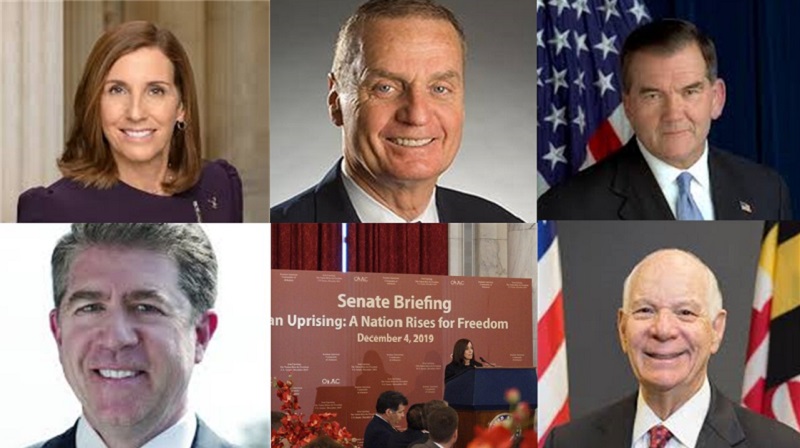
The United States Senate
hosted an event last week in support of the Iran protests for regime change.
Speakers at the event on December 4, 2019, included Senator Martha McSally (R-AZ); Senator Ben Cardin (D-MD) (via a message to the conference); General James Jones, former National Security Advisor to President Barack Obama; Governor Tom Ridge, former U.S. Homeland Security Secretary; and Ambassador Lincoln Bloomfield Jr., former U.S. Assistant Secretary of State for Political-Military Affairs. Iranian opposition leader expect the U.S. Congress, the United States, the European Union and all governments to recognize the struggle and the resistance of the Iranian people to overthrow the clerical regime pic.twitter.com/xu40Yw6nkn
— Maryam Rajavi (@Maryam_Rajavi) December 4, 2019
Mrs. Rajavi added: “The mullahs’ regime has no support among the people and lacks legitimacy….the regime has no solutions to offer for political and economic crises… The MEK’s efforts to build an organized movement succeeded. The resistance units of the MEK played a key role in the uprising… The answer to the problem of Iran is to overthrow the religious dictatorship, which is the desire of the Iranian people.”
She concluded: “The solution for the crises in the Middle East, from Iraq to Yemen, and from Syria to Lebanon, is the overthrow of this regime.”
“Governments and the international community must set aside any consideration or accommodation vis-à-vis Iran’s ruling theocracy and demand an immediate stop to the killings and arrests. And if the mullahs remain defiant, the UN must decisively put in place Security Council sanctions…European Union and the United States, to recognize the struggle and the resistance of the Iranian people to overthrow the clerical regime and support their right to resist against suppression and repression. The people of Iran expect Congress to lead the way in recognizing this noble right,” Mrs. Rajavi said.
General Jones said: “I really do think that hope is coming. I really do think that the regime is more vulnerable now than it ever has been and that there will be an end to this.”
As for the alternative to the regime, General Jones said: “The NCRI is a coalition that has democratically elected a leader. They have Jeffersonian democratic principles. It is something that we should celebrate… and I look forward to being with you in Tehran one of these days.”
General James Jones speaking at the briefing on the history of Iranian opposition @VOAIran @SecPompeo @CNNSitRoom pic.twitter.com/SJW2bby05l
— OIAC (@OrgIAC) December 4, 2019
Governor Ridge added how the NCRI for Iranians “is a national appeal for justice and freedom and independence…it’s about time that the United States of America leads that effort among democracies to not only condemn this regime but to publicly support the democratic uprising, proudly led, proudly led by the MEK.”
Former secretary @TomRidgeNews speaking at the Senate Briefing recalling when he start getting to know the the Iranian opposition @CNNSitRoom @SecPompeo @SenatorCardin @SenatorMenendez @SenMcSallyAZ @VOAIran pic.twitter.com/LaQ1ihjEOJ
— OIAC (@OrgIAC) December 4, 2019
Ambassador Bloomfield spoke on Iran’s history for democracy and freedom adding: “The National Council of Resistance of Iran, the Mujahedin-e-Khalq, living in Albania and the OIAC supporters here and all across the United States are all the intellectual heirs of Iran’s great nationalist hero Mossadegh and the freedom movement…people who stand for an Iran governed with democracy, freedom, self-determination, universal principles, and unalienable rights.”
Ambassador @LBJunior ar @OrgIAC Senate Briefing on Iran: And are you ready to identify people among the opposition groups of Iran who have a plan to move toward legitimate government, based on consent of the government?” @StateDept https://t.co/8IEA4QyYtK @VOAIran @USAdarFarsi
— OIAC (@OrgIAC) December 6, 2019
Mr. Tim Ghaemi delivered a message on behalf of OIAC calling on the United States, to “take tangible steps to the side with the protesters. One example is to prevent the Iranian regime from cutting off the Internet.”
While recognizing the strong bipartisan support for the protesters by US congressional leaders, he urged Congress to “introduce a language in no uncertain terms to hold the regime accountable for its crimes, side with the protesters who seek nothing but freedom, and to recognize the right of the Iranian people to unseat their repressive rulers.”
Mr. Tim Ghaemi from @OrgIAC: Iranians consider the regime &all its factions as illegitimate.The people are ready to pay the price to unseat mullahs! @SenatorMenendez @SenatorShaheenb @VOAIran @IranIntl_En pic.twitter.com/v6Huh7OUUz
— OIAC (@OrgIAC) December 4, 2019
Background on the Iran protests:
Iran is witnessing its greatest political upheaval since the 1979 revolution. Protests for regime change, with chants of ‘Death to the dictator”, have erupted in at least 180 cities.
Protesters have managed to take over or destroy hundreds of government centers, security outposts, and state-affiliated banks, gas stations, and seminaries.
The regime has resorted to brute repression, killing at least 1000 protesters and arresting thousands more. It also shut down Iran’s internet completely for a week, blocking images of the protests from reaching the outside world.
Iranian regime officials have stated:
- Hundreds of thousands of people took part in the Iran protests.
- The protesters demanded ‘regime change.’
- The Iranian opposition People’s Mojahedin Organization of Iran (PMOI), or Mujahedin-e-Khalq (MEK), was behind much of the protests.
- The Iran protests took place in at least 100 areas of the capital Tehran.
- The protests also took place in 27 of Iran’s 31 provinces.
- A state of emergency was declared in five of Iran’s provinces, including Tehran, Fars, Isfahan, and Khuzestan.
- Protesters destroyed at least 50 police and army centers, 140 government centers, 183 police vehicles, nine seminaries, 731 state-affiliated banks, and 70 gas stations.


